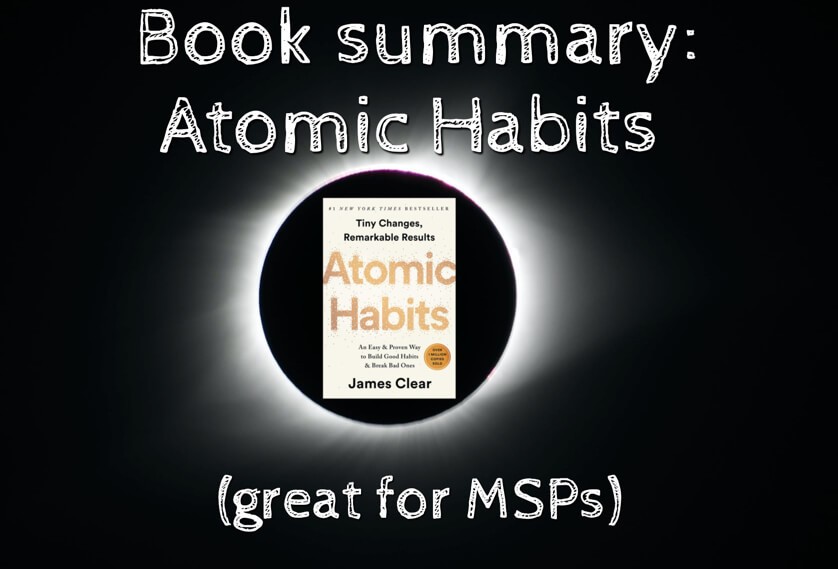So, two weeks in to the new year, the chances are that many of your good intentions have already fallen by the wayside.
That's OK. And perfectly normal.
I'm not talking about New Year's Resolutions. We're business owners, we don't really do those. But when we've had a good rest, we do come back into our businesses full of great ideas - that we know will make a big difference... IF we can get them to stick.
Cue my first book review of the year. It's Atomic Habits by James Clear (who I asked onto my podcast for February when we're featuring interviews from productivity experts... his team declined this time, but I will persist 😃)
I first read this last year, and instantly promoted it to the special shelf of my bedroom library, where my all-time favourite business books live.
Atomic Habits is a book set in the real world. Where it's bloody hard to get things done, no matter how clear your goals are or how motivated you are. So instead, you should put together a set of Atomic Habits.
An Atomic Habit is a small routine that's easy to do. You can link it to existing routines to make it something you perform on a regular basis. This is called habit stacking, and it's perfect for MSPs.
Here's a small example. I work permanently from home now, and when I finish work each day I shut my laptop. That's signified the end of my workday for years - once it's closed, it stays closed.
I leave the current business book I'm reading next to my laptop. And my habit now is that once I close the laptop, I grab my business book and spend at least 20 minutes on the sofa reading. Not only do I find this a relaxing transition from work life to home life, but I'm ploughing through business books again... a habit I lost in the first lockdown.
Another habit - I have an end of day routine which I follow every day. Where I order my to do list for the next day; then check messages on LinkedIn and my Facebook group.
I wanted to write a new article every single weekday for the vault in The War Room, my programme where I work closely with a growing number of MSPs (45 at time of writing). So I've inserted that into the end of day routine. For 10 working days in a row now I've written one of those articles. Because I've attached the habit to existing solid habits.
Feels great!
Recently I've re-read Atomic Habits. And I've done a quick summary of each chapter for you. This will give you an overview of the powerful ideas within. But I still recommend you get the proper book. No summary can ever do a full book justice.
Book summary of Atomic Habits, for MSPs
Chapter 1: This introduces us to the atomic habit; individually, a small and seemingly insignificant character trait. However, when many atomic habits are brought together as a group, they can be surprisingly powerful. James Clear refers to atomic habits as the ‘building blocks of remarkable results’.
His aim across this introductory chapter is to encourage us not to think of atomic habits singularly, and instead consider their impact as a group. ‘It’s not about any single accomplishment’.
Chapter 2: James Clear says that ‘the ultimate form of intrinsic motivation is when a habit becomes part of your identity’. He discusses how a better understanding of who you are, and focusing on who you wish to become, can make it easier to build habits that bridge the gap. According to James Clear, bridging the gap is very simple. All it takes is deciding who you want to be and making small changes to make it happen.
Chapter 3: James Clear makes it easy for us to understand the core makeup of an atomic habit by breaking it down into separate aspects: cue, craving, response, and reward. This notion says that every habit - both good and bad - is sparked by a specific cue, becomes an inherent focus due to natural craving, and is driven by both a person’s response to the situation and by reward from taking action.
Due to this continuous feedback loop that keeps old habits alive, he discusses how difficult it can be to break bad habits, as well as looking into the challenges of building good ones. Building habits, according to James Clear, doesn’t happen overnight. ‘A habit is a behaviour that has been repeated enough times to become automatic’. In this chapter, he first introduces his own 4-step process for good habit building:
1. Making the action something clear and obvious which can easily be done day to day
2. Making the action something that a person actually wants to do; something that isn’t a chore
3. Making the action something simple and straightforward so it can easily be repeated
4. Making the action satisfying so that it invokes the human reward function
Chapter 4: He continues discussing his 4-step approach to building habits. He believes that, by following the stages, the brain will begin to pick on environmental cues to invoke the newly formed good habit. However, James Clear is keen for us to understand that it can take time. ‘The process of behaviour change always starts with awareness’ he says. ‘You need to be aware of your habits before you can change them’. He says that habits become habits when we don’t consciously think about them.
Chapter 5: Here, James Clear goes into further detail about his 4-step approach. He offers actionable advice, recommending that we try to create clarity by matching a new behaviour with a tangible cue, such as a location. This can make it easier to identify cues and transform behaviours into automatic habits.
Towards the end of the chapter, he goes one step further to look at how building a single atomic habit can then facilitate the building of another, and another, and another, creating that powerful group that was first mentioned in the introduction. Referring to the process as ‘habit stacking’, James Clear promotes the idea of a single atomic habit as a secure and solid foundation for building up more positive behaviours.
Chapter 6: James Clear continues to discuss the cues that were mentioned in the previous chapter. He provides more information about the different types of cues that can be found within the environment and identifies the environment as one of the most overlooked aspects of shaping human behaviours. According to the author, habits sparked by a specific cue will eventually be sparked by surrounding aspects.
Chapter 7: He moves on from discussing building good habits to focus on breaking the bad ones. James Clear states that a habit cannot be broken; instead, we must make an effort to avoid the environment cue that sparks the habit, and for some, this can mean exerting excellent self-control.
‘People with high self-control tend to spend less time in tempting situations’ says James. ‘It’s easier to avoid temptation than to resist it’. He introduces the notion that by minimising exposure to the habit-sparking cue by avoiding certain situations, it can be possible to eliminate poor behaviours.
Chapter 8: James brings biological aspects into the equation, exploring why it is human nature to partake in certain habits, even if we know they are not good for us. He discusses the power of reward, and how the way that we reward ourselves for bad behaviours drives a never ending habit loop. His advice is ‘temptation bundling’; pairing a necessary behaviour with an enjoyable behaviour.
Chapter 9: The author looks at how trying to integrate with a group that doesn’t possess a shared identity can be detrimental and can cause people to form habits that don’t support the journey towards the person they want to be. His advice is to join a group where the characteristics of who you want to be are the norm. ‘The normal behaviour of the tribe often overpowers the desired behaviour of the individual’.
Chapter 10: James Clear once again flips back from habit building to habit breaking. In this chapter, he looks at why behaviours become habits - because we associate them with positive rewards - and suggests to us that by reversing the process, it may be possible to stop performing undesirable behaviours. ‘Habits are attractive when we associate them with positive feelings and unattractive when we associate them with negative feelings’. He recommends highlighting the positive impact of avoiding bad habits.
Chapter 11: Here, James Clear reintroduces the idea of patience in habit building. ‘The amount of time you have been performing a habit is not as important as the number of times you have performed it’. In this chapter, Clear wants us to understand that building and breaking atomic habits isn’t a quick fix, and no amount of planning can speed the process up. Instead, it is important to repeat good behaviours over and over, as this is the only way that behaviours can successfully be transformed into habits.
Chapter 12: The author discusses how our lifestyle can affect how easy - or how difficult - it is to build and break habits. He puts forward the idea that, as humans, we are more inclined and more motivated to do something if it’s easy, and we’re less likely to do something if it seems tricky. James Clear suggests to ‘prime your environment to make future actions easier’ while simultaneously taking measures to make it more cumbersome to undertake negative actions and display bad behaviours.
Chapter 13: James Clear advises us against running before we can walk. He warns of the dangers of building big habits too quickly and says that we should ‘standardise before you optimise’, suggesting that habits should initially be small, simple, and easy, before being improved and built upon. Clear introduces the ‘two-minute rule’, stating that new habits should take less than 2 minutes to do.
Chapter 14: James explores the differences between one-time actions and ingrained habitual behaviours. While one-time outcomes can change through variations in human choice, habits result in the same choices being made time after time. ‘The ultimate way to lock in future behaviour is to automate your habits’. Clear also touches upon the role of technology in automating certain habits - oh yes, this is one you can really get behind 🤣
Chapter 15: In this chapter, James Clear shares the ‘cardinal rule of behaviour change’: What is immediately rewarded is repeated, while what is immediately punished is avoided. Again, he brings biological aspects into this chapter, taking a closer look at the natural human desire for reward, and an inherent want to partake in rewarding behaviours. James says that rewarding behaviours are statistically more likely to be repeated.
Chapter 16: The author shares the importance of measuring success. He advises us to use a habit tracker, which can be something as simple as a wall calendar, to help us visualise their progress (that's a clever idea; I track mine in a book every day). He ends this chapter by discussing the normalcy of ‘falling off the wagon’, and how single ‘off’ days don’t break the chain. James says that it is possible to get back on track when things don’t go as planned.
Chapter 17: Here he tells us of the importance of having a strong support system in place. Discussing the natural human reliance on others, and the importance of ‘keeping up appearances’, Clear says that working with an accountability partner can increase the chance of forming good habits while breaking bad ones. ‘Knowing that someone else is watching you can be a powerful motivator’ he says.
Chapter 18: James Clear urges us not to make building new habits harder than it really needs to be. He advises we take a closer look at our own natural strengths and weaknesses, and choose to build habits that are in line with our own inherent abilities. ‘Pick the right habit and progress is easy’, says James. ‘Pick the wrong habit and life is a struggle’. He believes there is no ‘one size fits all’.
Chapter 19: In this chapter, he introduces the ‘Goldilocks Rule’; the idea that people are more motivated when they are working just outside of their comfort zone. Why? Because it keeps things interesting. ‘The greatest threat to success is not failure but boredom’. Clear warns that as once-interesting behaviours transform into habits, they can become mundane, and advises us to keep shaking things up.
Chapter 20: In the final chapter, James Clear explores the potential downsides of building new habits. He believes that as behaviours become habits, we naturally pay less and less attention to them as they are now automatic actions. And he urges us to continue improving upon behaviours and highlights the importance of staying aware of these actions. A conscious mind, he says, is the key to boosting overall performance.
Have you read Atomic Habits? What did you think to it? Drop me an email and let me know: hello@paulgreensmspmarketing.com






